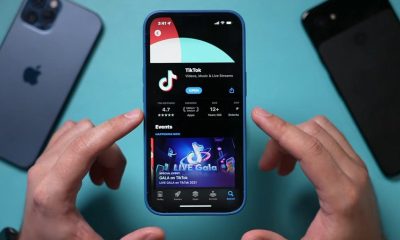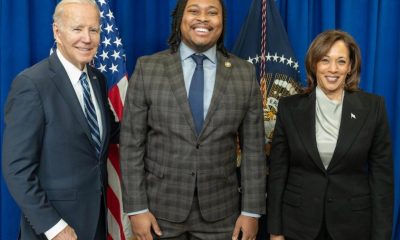Local
Mattachine founded 50 years ago
D.C. ‘homophile’ group remembered as first civil rights organization for gays
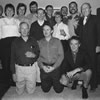
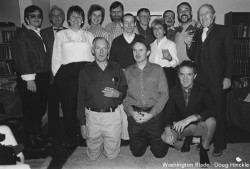
Frank Kameny, one of Mattachine’s founders, died last month, just prior to the organization’s 50th anniversary. The city staged a farewell for Kameny last week a the Carnegie Library. (Washington Blade file photo by Doug Hinckle)
Records kept by the late gay rights pioneer Frank Kameny show that Kameny and fellow activist and native Washingtonian Jack Nichols co-founded the Mattachine Society of Washington, D.C., on Nov. 15, 1961 as the city’s — and nation’s — first homosexual civil rights organization.
Kameny, then 36, and Nichols, 23, were joined by at least three others on that day at the group’s first official meeting, held in the Harvard Street, N.W., apartment of Earl Aiken, one of the group’s first members, according to information obtained by D.C.’s Rainbow History Project.
LGBT activists and Kameny’s friends and colleagues in D.C. and across the nation are scheduled to gather in Washington at the Cannon House Office Building on Capitol Hill next Tuesday, Nov. 15, for a memorial service celebrating Kameny’s life and legacy. The gay rights leader died at his home in Washington on Oct. 11. Organizers say the gathering will also commemorate the 50th anniversary of Kameny and his gay rights colleagues’ founding of the Mattachine Society of Washington.
The Rainbow History Project reports that an example of the hostile climate the fledgling group was to face in its first few years of existence in the early 1960s surfaced three months before its official launch, when Kameny organized a preliminary meeting to discuss the need for forming a homosexual rights group.
When Kameny and others sat down at the start of that meeting, held at the Hay Adams Hotel on Aug. 1, 1961, Kameny quickly discovered the gathering had been infiltrated by Louis Fouchette, the head of the Perversion Section of the D.C. Police Department’s Morals Division.
“Fouchette was identified, exposed, and left the meeting,” Rainbow History Project reports in one of its papers on the Mattachine Society of Washington.
Kameny told the Blade years later that he and others attending the August 1961 meeting viewed Fouchette’s visit, and the fact that he learned of plans to form a gay group before it even held its first meeting, as a chilling reminder of the work that lay ahead for the group.
In part because Mattachine’s organizers knew that discovery by authorities, including police, of someone’s status as a gay person would almost certainly lead to the loss of their job, the group adopted a bylaw making it mandatory that all members except Kameny use a pseudonym to identify themselves publicly. The pseudonyms would also be used on Mattachine’s membership list.
Among those complying with this requirement were Mattachine members Nichols, who later went on to become an accomplished author, journalist and out gay activist; Robert King, Lilli Vincenz, Paul Kuntzler, Eva Freund; Ron Balin; and Jon Swanson, according to Rainbow History’s reports on the group.
Each of them played a key role in Mattachine Society of Washington’s groundbreaking work, including the group’s first-ever homosexual rights protest demonstrations in the 1960s at the White House, Pentagon, Civil Service Commission and other government buildings.
Kuntzler later co-founded the D.C. Gay Activist Alliance, which later became the Gay and Lesbian Activists Alliance, and the Gertrude Stein Democratic Club, two of D.C.’s leading LGBT advocacy organizations that continue to operate today.
Back in 1961, Kameny chose to use his real name in connection with the Mattachine Society of Washington because he already suffered what he believed to be the irreversible consequences surrounding his firing in 1958 from his job as a civilian astronomer at the U.S. Army Map Service after authorities discovered he was gay.
“He knew he was essentially blacklisted for life in his profession as an astronomer, where, at the time, everybody knew each other in that profession,” said author and Kameny biographer David Carter. “So he had nothing to lose.”
Carter, who interviewed Kameny extensively during the past several years, said Kameny told him he chose to be one of the few “out” gays at the time following his unsuccessful but highly acclaimed appeal of his firing to the U.S. Supreme Court.
Kameny wrote his own brief to the high court as a document known as a Petition for a Writ of Certiorari, which asked the court to take on his case. In 1961, the Supreme Court denied his petition and upheld a lower court decision that refused to back a Kameny lawsuit seeking to force the U.S. Civil Service Commission to overturn his firing.
The lawsuit and his petition to the Supreme Court marked the first known time a gay person had challenged the U.S. government policy of refusing to hire and automatically firing gay people from federal government employment in any capacity or position.
Kameny’s 61-page Supreme Court petition, which is now part of the Kameny Papers collection at the Library of Congress, is viewed today by historians as the first comprehensive gay rights manifesto in the United States.
Carter, who is writing Kameny’s biography, said the Supreme Court petition became the founding principles used by Mattachine Society of Washington to carry out its work calling for equality and non-discrimination for homosexuals in employment and a wide range of other areas.
Origin of ‘Mattachine’ name
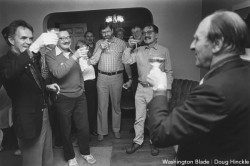
Local activists commemorate the 25th anniversary of the founding of the Mattachine Society on Nov. 15, 1986. (Blade archive photo by Doug Hinckle)
There were other Mattachine Society groups created by gays in other cities beginning in Los Angeles in 1950. But nearly all of them acted as clandestine groups seeking to promote a better understanding of homosexuals, with most agreeing with the then prevailing view by psychiatric professionals that homosexuality was a mental disorder.
The Mattachine name was first adopted in 1950 by pioneering gay rights activist Harry Hay, the lead founder that year in Los Angeles of the first such group. Hay said he took the name from a French medieval and renaissance group known as Société Mattachine, which operated within the royal court as court-jester type figures wearing masks to conceal their identity. In some cases the Mattachines were believed to have been given liberty to speak frankly to the ruling monarch on matters that others were forbidden to discuss.
Carter said Kameny favored using another name for the Washington group that boldly used the word homosexual in its title. He said Kameny told him he was outvoted by the other members, who thought “Mattachine” was a name widely recognized within the nation’s homophile movement.
While insisting on adopting Mattachine Society as its name, Carter and others familiar with the group said the members agreed to Kameny’s request that it remain independent of other Mattachine Society groups, with whose philosophy and tactics Kameny disagreed.
None of the other Mattachine Society groups, including those located in L.A., San Francisco, and New York, took on the role of a civil rights and civil liberties organization like the Mattachine Society of Washington did.
“They certainly were the first to take that position,” said Carter, in discussing Mattachine Society of Washington’s activist, civil rights stance. “And the second unique thing about them is their attitude or strategy. They took a militant approach toward achieving that goal, an unapologetic approach,” he said.
“It is time that a strong initiative be taken to obtain for the homosexual minority – a minority in no way different, as such, from other of our national minority groups – the same rights, provided in the Constitution and the Declaration of Independence, as are guaranteed to all other citizens,” the Mattachine Society of Washington said in an August 1962 statement.
“These include the rights to the pursuit of happiness and to equality of opportunity; the right, as human beings, to develop and achieve their full potential and dignity; and the right, as citizens, to be allowed to make their maximum contribution to the society in which they live – rights which Federal policy and practice now deny,” the statement says.
In what Carter and others following the LGBT rights movement say was a first of its kind development, the group launched a four-point campaign in 1962 calling for repeal of the U.S. Civil Service Commission’s policy barring gay employees, which it called unconstitutional; an end to the U.S. military ban on gay service members; an end to the federal government policy of denying security clearances for gays; and the repeal of state sodomy laws that made it illegal for consenting adults of the same sex to engage in private sexual relations.
Kuntzler said the group went one step further by taking what others in the homophile movement at the time considered a radical action. Following a heated debate among its members at an April 1965 meeting, Mattachine Society of Washington adopted a formal resolution declaring that homosexuality was not a mental disorder.
The resolution, introduced by Kameny, opened the way for the group to begin a national campaign to pressure the American Psychiatric Association to remove homosexuality from its diagnostic manual as a disorder.
Kuntzler said he recalls members voted 27 to 5 to approve the resolution, with the group’s then president, Bob Belanger among those who voted against it.
“The Mattachine Society of Washington takes the position that in the absence of valid evidence to the contrary, homosexuality is not a sickness, disturbance or other pathology in any sense but is merely a preference, orientation, or propensity on par with and not different in kind from heterosexuality,” the resolution states.
Kuntzler also recalled that the group got an unexpected flurry of publicity in the summer of 1963 when then U.S. Rep. John Dowdy (D-Texas), who chaired the House committee overseeing D.C. affairs, called a public hearing on a bill he introduced to curtail the activities of the Mattachine Society of Washington.
The Washington Post reported in an Aug. 10, 1963 story that Dowdy became outraged when he learned that a D.C. government agency had granted Mattachine a license to solicit charitable contributions in the city as a fundraising tool. The Post story said Dowdy’s bill called for overturning the city’s approval of the group’s charitable solicitation license and called for barring the city from approving any future license to any organization whose existence threatened to harm “the health, welfare and morals” of the city.
Kameny drew widespread media coverage when he testified at the hearing in opposition to the bill and challenged Dowdy’s assumptions that homosexuality was a “perversion” harmful to society. A representative of the D.C. chapter of the American Civil Liberties Union also testified against the bill, saying it was unconstitutional because it would infringe on Mattachine’s First Amendment right of freedom of expression.
Kuntzler said that much to Dowdy’s horror, the testimony by Kameny and the ACLU official resonated with the public and media, prompting a Post editorial opposing the bill and calling Dowdy a “moralist.”
The bill eventually died in committee. The brouhaha surrounding its introduction and the hearing helped to boost the Mattachine Society’s message of equality and non-discrimination for gay people, Kameny and other members of the group concluded at the time.
The Mattachine Society of Washington became less active following the Stonewall riots in New York in 1969, which was considered a momentous development in the gay rights movement that led to the creation of a plethora of other gay groups, including D.C.’s short-lived Gay Liberation Front.
According to Kuntzler, nearly all of Mattachine’s small corps of remaining members devoted their time and energy in 1971 to Kameny’s historic run as the nation’s first known openly gay candidate for Congress. Kameny became one of five candidates competing for the newly created non-voting delegate seat in the House of Representatives to represent D.C. in Congress.
Mattachine members, among other things, organized a first-of-its-kind “gay” questionnaire for each of the candidates running in the race, asking them to state their views on gay-related issues, including whether they would support legislation to ban discrimination against homosexuals in employment.
All but Kameny ignored the questionnaire, Kuntzler said. But he said the questionnaire and the election-related work performed by Mattachine members laid the groundwork for the type of gay rights work assumed by the Gay Activists Alliance, which formed as the recognized successor to Mattachine Society of Washington immediately following Kameny’s run for Congress.
Kameny finished fourth in the election, receiving 1,888 votes or 11 percent of the total, Kuntzler recalls. In a development that surprised many and delighted LGBT activists, Kameny finished ahead of the Rev. Douglas Moore, the fifth place candidate who denounced homosexuality and gays as being “immoral” and a threat to the community.
“It was a very nice place to be,” said lesbian activist Lilli Vincenz, who said she joined Mattachine Society of Washington in 1962 after being discharged from the Women’s Army Corps, or WACs, on grounds of homosexuality. “I was glad to be a part of it.”
Vincenz was among many of the group’s early members who went on to successful professional careers in the D.C. area while they continued to participate in the LGBT rights movement. All of them switched to using their real names.
Eva Freund, who, like Vincenz and Mattachine member Nancy Tucker, became among the group’s first female members, continued to participate in LGBT-related causes. She currently serves as president of a D.C.-area information technology services company.
Vincenz received a doctorate degree in psychology and operated a therapist practice specializing in helping lesbian and gay clients. Kuntzler became an advertising executive for a non-profit association and his longtime domestic partner, Steven Miller, who also participated in Mattachine activities, became the owner of a successful court reporting business.
Tucker and Vincenz also became coordinators of a Mattachine newsletter project that led them to found an independent gay newspaper in the city in October of 1969 called the Gay Blade, which later evolved into the Washington Blade.
District of Columbia
Catching up with the asexuals and aromantics of D.C.
Exploring identity and finding community
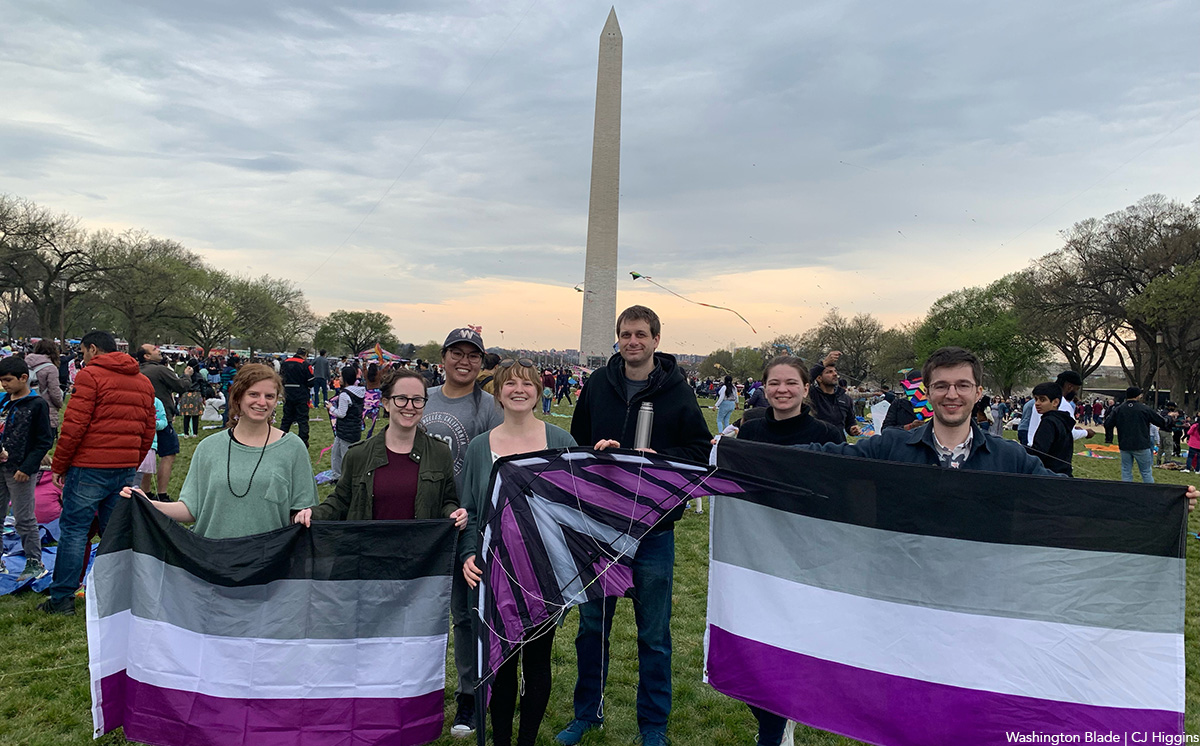
There was enough commotion in the sky at the Blossom Kite Festival that bees might have been pollinating the Washington Monument. I despaired of quickly finding the Asexuals and Aromantics of the Mid-Atlantic—I couldn’t make out a single asexual flag among the kites up above. I thought to myself that if it had been the Homosexuals of the Mid-Atlantic I would’ve had my gaydar to rely on. Was there even such a thing as ace-dar?
As it turned out, the asexual kite the group had meant to fly was a little too pesky to pilot. “Have you ever used a stunt kite?” Bonnie, the event organizer asked me. “I bought one. It looked really cool. But I can’t make it work.” She sighed. “I can’t get the thing six feet off the ground.” The group hardly seemed to care. There was caramel popcorn and cookies, board games and head massages, a game of charades with more than its fair share of Pokémon. The kites up above might as well have been a coincidental sideshow. Nearly two dozen folks filtered in and out of the picnic throughout the course of the day.
But I counted myself lucky that Bonnie picked me out of the crowd. If there’s such a thing as ace-dar, it eludes asexuals too. The online forum for all matters asexual, AVEN, or the Asexual Visibility and Education Network, is filled with laments: “I don’t think it’s possible.” “Dude, I wish I had an ace-dar.” “If it exists, I don’t have it.” “I think this is just like a broken clock is right twice a day type thing.” What seems to be a more common experience is meeting someone you just click with—only to find out later that they’re asexual. A few of the folks I met described how close childhood friends of theirs likewise came out in adulthood, a phenomenon that will be familiar to many queer people. But it is all the more astounding for asexuals to find each other this way, given that asexual people constitute 1.7% of sexual minorities in America, and so merely .1% of the population at large.
To help other asexuals identify you out in the world, some folks wear a black ring on their middle finger, much as an earring on the right ear used to signify homosexuality in a less welcoming era. The only problem? The swinger community—with its definite non-asexuality—has also adopted the signal. “It’s still a thing,” said Emily Karp. “So some people wear their ace rings just to the ace meet-ups.” Karp has been the primary coordinator for the Asexuals and Aromantics of the Mid-Atlantic (AAMA) since 2021, and a member of the meet-up for a decade. She clicked with the group immediately. After showing up for a Fourth of July potluck in the mid-afternoon, she ended up staying past midnight. “We played Cards against Humanity, which was a very, very fun thing to do. It’s funny in a way that’s different than if we were playing with people that weren’t ace. Some of the cards are implying, like, the person would be motivated by sex in a way that’s absurd, because we know they aren’t.”
Where so many social organizations withered during the pandemic, the AAMA flourished. Today, it boasts almost 2,000 members on meetup.com. Karp hypothesized that all the social isolation gave people copious time to reflect on themselves, and that the ease of meeting up online made it convenient as a way for people to explore their sexual identity and find community. Online events continue to make up about a third of the group’s meet-ups. The format allows people to participate who live farther out from D.C. And it allows people to participate at their preferred level of comfort: while many people participate much as they would at an in-person event, some prefer to watch anonymously, video feed off. Others prefer to participate in the chat box, though not in spoken conversation.
A recent online event was organized for a discussion of Rhaina Cohen’s book, “The Other Significant Others,” published in February. Cohen’s book discusses friendship as an alternative model for “significant others,” apart from the romantic model that is presupposed to be both the center and goal of people’s lives. The AAMA group received the book with enthusiasm. “It literally re-wired my brain,” as one person put it. People discussed the importance of friendship to their lives, and their difficulties in a world that de-prioritized friendship. “I can break up with a friend over text, and we don’t owe each other a conversation,” one said. But there was some disagreement when it came to the book’s discussion of romantic relationships. “It relegates ace relationships to the ‘friend’ or ‘platonic’ category, to the normie-reader,” one person wrote in the chat. “Our whole ace point is that we can have equivalent life relationships to allo people, simply without sex.” (“Allo” is shorthand for allosexual or alloromantic, people who do experience sexual or romantic attraction.)
The folks of the AAMA do not share a consensus on the importance of romantic relationships to their lives. Some asexuals identify as aromantic, some don’t. And some aromantics don’t identify as asexual, either. The “Aromantic” in the title of the group is a relatively recent addition. In 2017, the group underwent a number of big changes. The group was marching for the first time in D.C. Pride, participating in the LGBTQ Creating Change conference, and developing a separate advocacy and activism arm. Moreover, the group had become large enough that discussions were opened up into forming separate chapters for D.C., Central Virginia, and Baltimore. During those discussions, the group leadership realized that aromantic people who also identified as allosexual didn’t really have a space to call their own. “We were thinking it would be good to probably change the name of the Meetup group,” Emily said. “But we were not 100% sure. Because [there were] like 1,000 people in the group, and they’re all aces, and it’s like, ‘Do you really want to add a non-ace person?’” The group leadership decided to err on the side of inclusion. “You know, being less gatekeep-y was better. It gave them a place to go — because there was nowhere else to go.”
The DC LGBT Center now sponsors a support group for both asexuals and aromantics, but it was formed just a short while ago, in 2022. The founder of the group originally sought out the center’s bisexual support group, since they didn’t have any resources for ace folks. “The organizer said, you know what, why don’t we just start an ace/aro group? Like, why don’t we just do it?” He laughed. “I was impressed with the turnout, the first call. It’s almost like we tapped into, like, a dam. You poke a hole in the dam, and the water just rushes out.” The group has a great deal of overlap with the AAMA, but it is often a person’s first point of contact with the asexual and aromantic community in D.C., especially since the group focuses on exploring what it means to be asexual. Someone new shows up at almost every meeting. “And I’m so grateful that I did,” one member said. “I kind of showed up and just trauma dumped, and everyone was really supportive.”
Since the ace and aro community is so small, even within the broader queer community, ace and aro folks often go unrecognized. To the chagrin of many, the White House will write up fact sheets about the LGBTQI+ community, which is odd, given that when the “I” is added to the acronym, the “A” is usually added too. OKCupid has 22 genders and 12 orientations on its dating website, but “aromantic” is not one of them — presumably because aromantic people don’t want anything out of dating. And since asexuality and aromanticism are defined by the absence of things, it can seem to others like ace and aro people are ‘missing something.’ One member of the LGBT center support group had an interesting response. “The space is filled by… whatever else!” they said. “We’re not doing a relationship ‘without that thing.’ We’re doing a full scale relationship — as it makes sense to us.”
CJ Higgins is a postdoctoral fellow with the Alexander Grass Humanities Institute at Johns Hopkins University.
District of Columbia
Bowser budget proposal calls for $5.25 million for 2025 World Pride
AIDS office among agencies facing cuts due to revenue shortfall
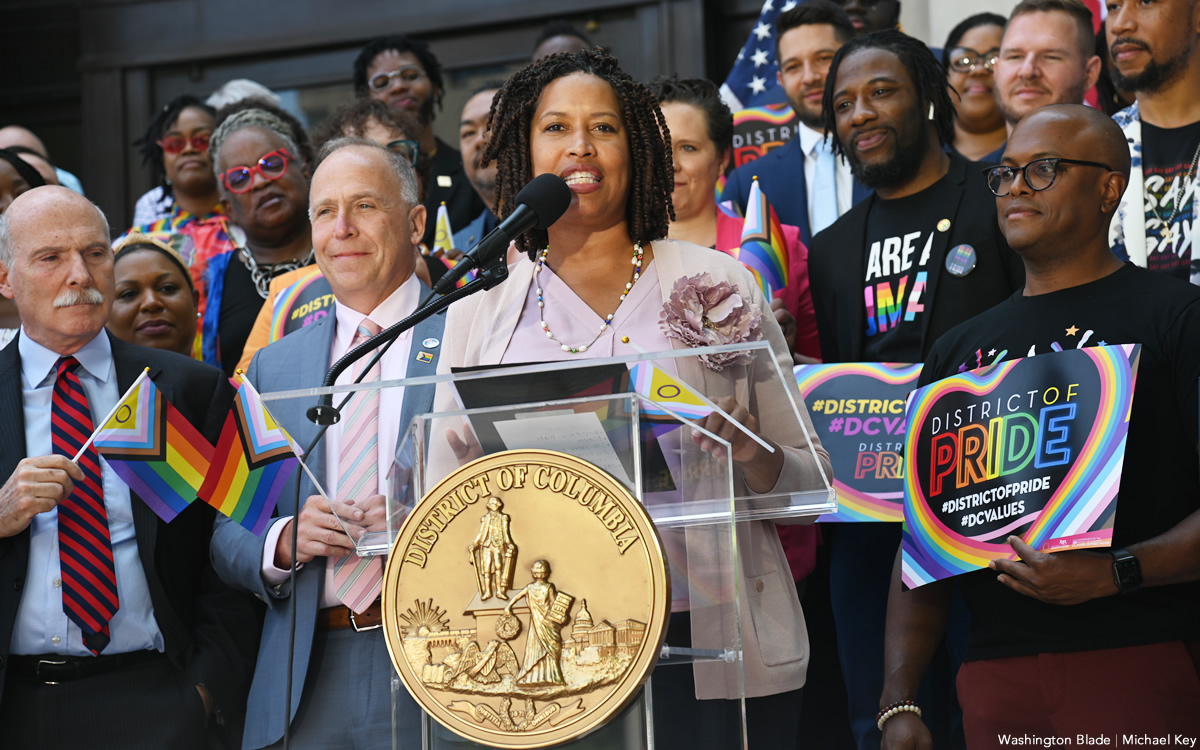
D.C. Mayor Muriel Bowser’s proposed fiscal year 2025 budget includes a request for $5.25 million in funding to support the June 2025 World Pride celebration, which D.C. will host, and which is expected to bring three million or more visitors to the city.
The mayor’s proposed budget, which she presented to the D.C. Council for approval earlier this month, also calls for a 7.6 percent increase in funding for the Mayor’s Office of LGBTQ Affairs, which amounts to an increase of $132,000 and would bring the office’s total funding to $1.7 million. The office, among other things, provides grants to local organizations that provide services to the LGBTQ community.
Among the other LGBTQ-related funding requests in the mayor’s proposed budget is a call to continue the annual funding of $600,000 to provide workforce development services for transgender and gender non-conforming city residents “experiencing homelessness and housing instability.” The budget proposal also calls for a separate allocation of $600,000 in new funding to support a new Advanced Technical Center at the Whitman-Walker Health’s Max Robinson Center in Ward 8.
Among the city agencies facing funding cuts under the mayor’s proposed budget is the HIV/AIDS, Hepatitis, Sexually Transmitted Disease, and Tuberculosis Administration, known as HAHSTA, which is an arm of the D.C. Department of Health. LGBTQ and AIDS activists have said HAHSTA plays an important role in the city’s HIV prevention and support services. Observers familiar with the agency have said it recently lost federal funding, which the city would have to decide whether to replace.
“We weren’t able to cover the loss of federal funds for HAHSTA with local funds,” Japer Bowles, director of the Mayor’s Office of LGBTQ Affairs, told the Washington Blade. “But we are working with partners to identify resources to fill those funding gaps,” Bowles said.
The total proposed budget of $21 billion that Bowser submitted to the D.C. Council includes about $500 million in proposed cuts in various city programs that the mayor said was needed to offset a projected $700 million loss in revenue due, among other things, to an end in pandemic era federal funding and commercial office vacancies also brought about by the post pandemic commercial property and office changes.
Bowser’s budget proposal also includes some tax increases limited to sales and business-related taxes, including an additional fee on hotel bookings to offset the expected revenue losses. The mayor said she chose not to propose an increase in income tax or property taxes.
Earlier this year, the D.C. LGBTQ+ Budget Coalition, which consists of several local LGBTQ advocacy organizations, submitted its own fiscal year 2025 budget proposal to both Bowser and the D.C. Council. In a 14-page letter the coalition outlined in detail a wide range of funding proposals, including housing support for LGBTQ youth and LGBTQ seniors; support for LGBTQ youth homeless services; workforce and employment services for transgender and gender non-conforming residents; and harm reduction centers to address the rise in drug overdose deaths.
Another one of the coalition’s proposals is $1.5 million in city funding for the completion of the D.C. Center for the LGBTQ Community’s new building, a former warehouse building in the city’s Shaw neighborhood that is undergoing a build out and renovation to accommodate the LGBTQ Center’s plans to move in later this year. The coalition’s budget proposal also calls for an additional $300,000 in “recurring” city funding for the LGBTQ Center in subsequent years “to support ongoing operational costs and programmatic initiatives.”
Bowles noted that Bowser authorized and approved a $1 million grant for the LGBTQ Center’s new building last year but was unable to provide additional funding requested by the budget coalition for the LGBTQ Center for fiscal year 2025.
“We’re still in this with them,” Bowles said. “We’re still looking and working with them to identify funding.”
The total amount of funding that the LGBTQ+ Budget Coalition listed in its letter to the mayor and Council associated with its requests for specific LGBTQ programs comes to $43.1 million.
Heidi Ellis, who serves as coordinator of the coalition, said the coalition succeeded in getting some of its proposals included in the mayor’s budget but couldn’t immediately provide specific amounts.
“There are a couple of areas I would argue we had wins,” Ellis told the Blade. “We were able to maintain funding across different housing services, specifically around youth services that affect folks like SMYAL and Wanda Alston.” She was referring to the LGBTQ youth services group SMYAL and the LGBTQ organization Wanda Alston Foundation, which provides housing for homeless LGBTQ youth.
“We were also able to secure funding for the transgender, gender non-conforming workforce program,” she said. “We also had funding for migrant services that we’ve been advocating for and some wins on language access,” said Ellis, referring to programs assisting LGBTQ people and others who are immigrants and aren’t fluent in speaking English.
Ellis said that although the coalition’s letter sent to the mayor and Council had funding proposals that totaled $43.1 million, she said the coalition used those numbers as examples for programs and policies that it believes would be highly beneficial to those in the LGBTQ community in need.
“I would say to distill it down to just we ask for $43 million or whatever, that’s not an accurate picture of what we’re asking for,” she said. “We’re asking for major investments around a few areas – housing, healthcare, language access. And for capital investments to make sure the D.C. Center can open,” she said. “It’s not like a narrative about the dollar amounts. It’s more like where we’re trying to go.”
The Blade couldn’t’ immediately determine how much of the coalition’s funding proposals are included in the Bowser budget. The mayor’s press secretary, Daniel Gleick, told the Blade in an email that those funding levels may not have been determined by city agencies.
“As for specific funding levels for programs that may impact the LGBTQ community, such as individual health programs through the Department of Health, it is too soon in the budget process to determine potential adjustments on individual programs run though city agencies,” Gleick said.
But Bowles said several of the programs funded in the mayor’s budget proposal that are not LGBTQ specific will be supportive of LGBTQ programs. Among them, he said, is the budget’s proposal for an increase of $350,000 in funding for senior villages operated by local nonprofit organizations that help support seniors. Asked if that type of program could help LGBTQ seniors, Bowles said, “Absolutely – that’s definitely a vehicle for LGBTQ senior services.”
He said among the programs the increased funding for the mayor’s LGBTQ Affairs office will support is its ongoing cultural competency training for D.C. government employees. He said he and other office staff members conduct the trainings about LGBTQ-related issues at city departments and agencies.
Bowser herself suggested during an April 19 press conference that local businesses, including LGBTQ businesses and organizations, could benefit from a newly launched city “Pop-Up Permit Program” that greatly shortens the time it takes to open a business in vacant storefront buildings in the downtown area.
Bowser and Nina Albert, D.C. Deputy Mayor for Planning and Economic Development, suggested the new expedited city program for approving permits to open shops and small businesses in vacant storefront spaces could come into play next year when D.C. hosts World Pride, one of the word’s largest LGBTQ events.
“While we know that all special events are important, there is an especially big one coming to Washington, D.C. next year,” Bowser said at the press conference. “And to that point, we proposed a $5.25 million investment to support World Pride 2025,” she said, adding, “It’s going to be pretty great. And so, we’re already thinking about how we can include D.C. entrepreneurs, how we’re going to include artists, how we’re going to celebrate across all eight wards of our city as well,” she said.
Among those attending the press conference were officials of D.C.’s Capital Pride Alliance, which will play a lead role in organizing World Pride 2025 events.
Maryland
Health care for Marylanders with HIV is facing huge cuts this summer
Providers poised to lose three-quarters of funding
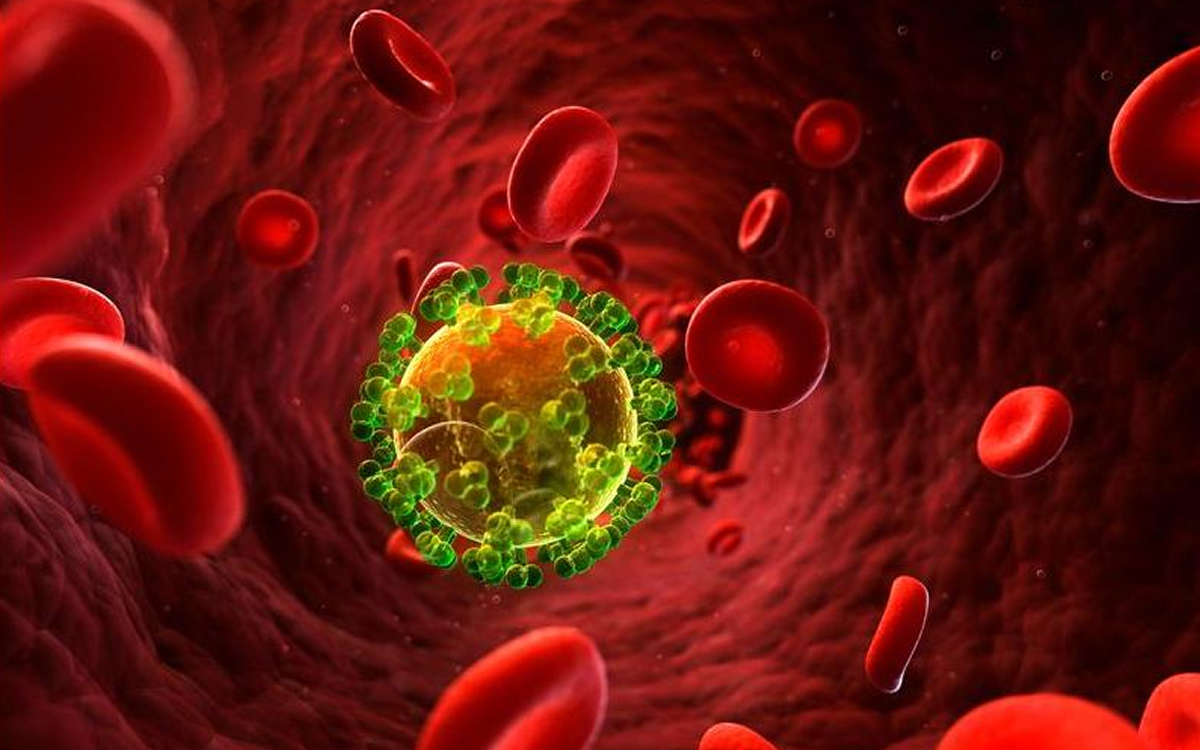
BY MEREDITH COHN | By the end of June, health care providers in Maryland will lose nearly three-quarters of the funding they use to find and treat thousands of people with HIV.
Advocates and providers say they had been warned there would be less money by the Maryland Department of Health, but were stunned at the size of the drop — from about $17.9 million this fiscal year to $5.3 million the next. The deep cuts are less than three months away.
The rest of this article can be read on the Baltimore Banner’s website.
-

 State Department2 days ago
State Department2 days agoState Department releases annual human rights report
-

 Maryland4 days ago
Maryland4 days agoJoe Vogel campaign holds ‘Big Gay Canvass Kickoff’
-

 Politics3 days ago
Politics3 days agoSmithsonian staff concerned about future of LGBTQ programming amid GOP scrutiny
-

 The White House1 day ago
The White House1 day agoWhite House debuts action plan targeting pollutants in drinking water

